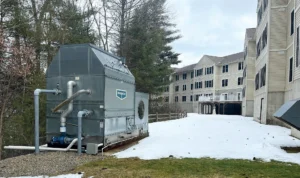An article published by the CDC in April and other recent press have brought to light evidence that the COVID-19 virus may remain airborne for longer times and further distances than initially thought and that HVAC has a role in reducing the spread of infection. This reporting comes at a time when businesses and buildings continue to reopen, leaving facilities executives to question whether their existing systems can adequately reduce airborne exposures.
Agencies including the EPA, CDC, ASHRAE and others agree and stress the importance of conducting a thorough HVAC equipment inspection, replacing system filters, and flushing buildings with fresh air 24 hours preoccupancy. The key components to minimizing risk include controlling air filtration, air flow, and humidity, and the reason that shutting down your system is not advisable.
Before making any changes or adjustments, it is crucial to evaluate your facility’s HVAC equipment and building operations to determine what it can actually accommodate. For example, if the blower motor of the air handling unit in your system does not have sufficient power, you may not be able to increase the level of air filtration.
HVAC filters with MERV (minimum efficiency reporting values) of 6-8 are commonly found in commercial air handling units. ASHRAE recommends a higher efficiency rating, such as MERV 13 or MERV 14 if the system can accommodate it. Some systems might not be able to handle a higher quality filter because it requires more energy to push air through it.
There have been many inquiries about installing HEPA (high efficiency particulate air) filters but they are generally not a better alternative for standard commercial environments. Without the right system, such as those used in laboratories and hospitals, the HEPA filter’s resistance to air flow is so significant that it could cause motor problems and other issues. They are also higher in cost.
Filtration is only part of the equation. The HVAC system must also maintain proper air flow and relative humidity levels. There are a variety of measures that can be implemented to control the flow of air in terms of speed, exchange and direction. Well circulated air will also help maintain humidity levels.
Making modifications to heating, ventilation, and air-conditioning systems that may help reduce the spread of COVID-19 starts with a thorough equipment inspection and assessment.
For additional guidance, recommendations or service, please give us a call at 617-779-9500 or complete the contact us form here.



